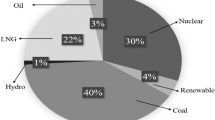Abstract
With the growing interest in solar (photovoltaic) PV systems like standalone or grid connected, rooftop or building integrated it has become important to provide the solution for site dependent performance of the system. Since drop in voltage is more sensitive to temperature rather than rising in current, hence module temperature is key parameter to be determined accurately in order to decide the size the of the module as well overall PV size. This voltage drop also impact the DC string as well as AC side voltage. Several researchers have evaluated the impact of temperature on module performance but since it is site dependent hence an experiment is conducted in Mathura (27.4924° N, 77.6737° E) to observe the impact of module temperature on the performance of the PV system in real climate conditions. The observations are that mean square error (MSE), root mean square error (RMSE), mean bias error (MBE), standard deviation error (SDE) between simulated and experimental energy are minimum in comparison to standard approach which does not include wind effect. More over the size of the system can be reduced from 2.8 to 6% and margin of disconnection from load due to sudden disturbances like passing of clouds over the PV system is 0.14 s (7 cycles) more, provided that module temperature must be determined accurately.













Similar content being viewed by others
REFERENCES
Dubey, S., Sarvaiya, J.N., and Seshadri, B., Temperature dependent photovoltaic (PV) efficiency and its effect on PV production in the world – A review, Energy Procedia, 2013, vol. 33, pp. 311–321.
Zondag, H.A., et al., The yield of different combined PV-thermal collector designs, Sol. Energy, 2003, vol. 74, no. 3, pp. 253–269.
Chow, T.T., Performance analysis of photovoltaic-thermal collector by explicit dynamic model, Sol. Energy, 2003, vol. 75, no. 2, pp. 143–152.
Gökmen, N., et al., Investigation of wind speed cooling effect on PV panels in windy locations, Renewable Energy, 2016, vol. 90, pp. 283–290.
Schwingshackl, C., et al., Wind effect on PV module temperature: Analysis of different techniques for an accurate estimation, Energy Procedia, 2013, vol. 40, pp. 77–86.
Skoplaki, E., Boudouvis, A.G., and Palyvos, J.A., A simple correlation for the operating temperature of photovoltaic modules of arbitrary mounting, Sol. Energy Mater. Sol. Cells, 2008, vol. 92, no. 11, pp. 1393–1402.
Kurtz, S., et al., Evaluation of high-temperature exposure of rack-mounted photovoltaic modules, 34th IEEE Photovoltaic Specialists Conference (PVSC), 2009.
Koehl, M., et al., Modeling of the nominal operating cell temperature based on outdoor weathering, Sol. Energy Mater. Sol. Cells, 2011, vol. 95, no. 7, pp. 1638–1646.
Mattei, M., et al., Calculation of the polycrystalline PV module temperature using a simple method of energy balance, Renewable Energy, 2006, vol. 31, no. 4, pp. 553–567.
Armstrong, S. and Hurley, W.G., A thermal model for photovoltaic panels under varying atmospheric conditions, Appl. Therm. Eng., 2010, vol. 30, nos. 11–12, pp. 1488–1495.
Ayompe, L.M., et al., Measured performance of a 1.72 kW rooftop grid connected photovoltaic system in Ireland, Energy Convers. Manage., 2011, vol. 52, no. 2, pp. 816–825.
Bhattacharya, T., Chakraborty, A.K., and Pal, K., Effects of ambient temperature and wind speed on performance of monocrystalline solar photovoltaic module in Tripura, India, J. Sol. Energy, 2014, id. 817078.
Sanjay, A. and Tiwari, G.N., Energy and exergy analysis of hybrid micro-channel photovoltaic thermal module, Sol. Energy, 2011, vol. 85, no. 2, pp. 356–370.
Mukerjee, A.K. and Thakur, N., Photo Voltaic Systems: Analysis and Design, Delhi: PHI, 2014.
Strobach, E., et al., Modeling a grid-connected concentrator photovoltaic system, Prog. Photovoltaics: Res. Appl., 2015, vol. 23, no. 5, pp. 582–592.
Morjaria, M., et al., A grid-friendly plant: The role of utility-scale photovoltaic plants in grid stability and reliability, IEEE Power Energy Mag., 2014, vol. 12, no. 3, pp. 87–95.
Sachin, S., Solar PV Plant Model Validation for Grid Integration Studies, Tempe, AZ: Arizona State Univ., 2014.
Subhash, C., Sanjay, A., and Chauhan, D.S., Soft computing based approach to evaluate the performance of solar PV module considering wind effect in laboratory condition, Energy Rep., 2018, vol. 4, pp. 252–259.
Ceylan, İ., et al., The prediction of photovoltaic module temperature with artificial neural networks, Case Studies Therm. Eng., 2014, vol. 3, pp. 11–20.
Kalogirou, S.A., Mathioulakis, E., and Belessiotis, V., Artificial neural networks for the performance prediction of large solar systems, Renewable Energy, 2014, vol. 63, pp. 90–97.
Namrata, K., Sharma, S.P., and Seksena, S.B.L., Comparison of different models for estimation of diffuse solar radiation in Jharkhand (India) region, Appl. Sol. Energy, 2015, vol. 51, no. 3, pp. 219–224.
Namrata, K., Sharma, S.P., and Seksena, S.B.L., Empirical models for the estimation of global solar radiation with sunshine hours on horizontal surface for Jharkhand (India), Appl. Sol. Energy, 2016, vol. 52, no. 3, pp. 164–172.
ACKNOWLEDGMENTS
Authors are very thankful to the electrical maintenance department of the GLA University for providing the necessary data and required support about the 25 KWp Solar PV system. Besides this authors are also thankful to laboratory technical staff for their untiring efforts.
Funding
All the required equipments were purchased by Solar Energy Laboratory of Electrical Engineering department.
Author information
Authors and Affiliations
Corresponding author
About this article
Cite this article
Subhash Chandra, Agrawal, S. & Chauhan, D.S. Impact of Photovoltaic Module Temperature on Size and Voltage Stability, a Case Study in Indian Climate. Appl. Sol. Energy 56, 324–333 (2020). https://doi.org/10.3103/S0003701X20050059
Received:
Revised:
Accepted:
Published:
Issue Date:
DOI: https://doi.org/10.3103/S0003701X20050059




